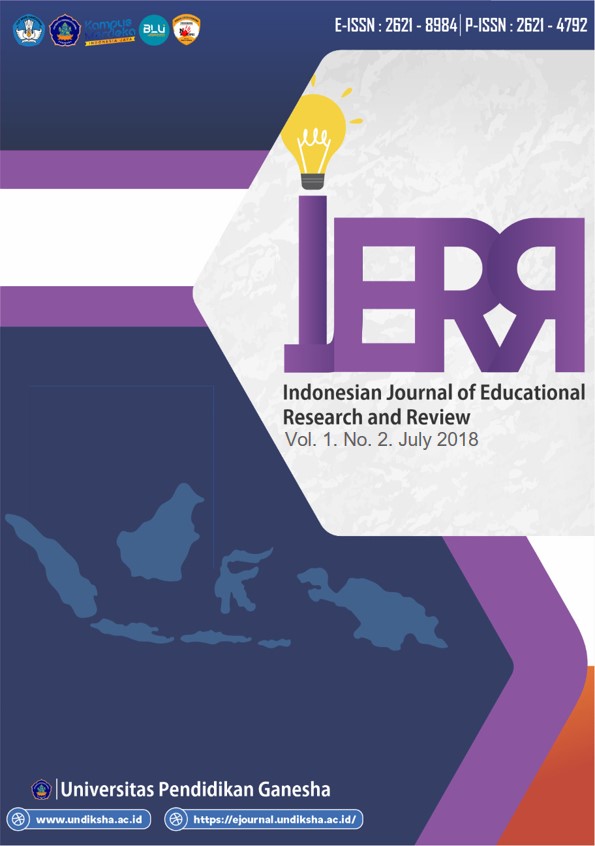MODEL LATIHAN IMAGERY SEBAGAI PENDUKUNG KETEPATAN WAKTU PENCAK SILAT KATEGORI TUNGGAL, GANDA DAN REGU
DOI:
https://doi.org/10.23887/ijerr.v1i2.15534Abstrak
This study aims to produce a model of imagery training as a support for the timeliness, of pencak silat in the category of single, double, team (TGR). The method in this study is Research and Development that produces imagery models in the user guide for Special Cognitive Practices, Motivational Specific, Motivational General Arosual, Motivational General. Subjects were coach and single, double, and team kategories PPLD pencak silat Musi Banyuasin regency, South Sumatra Province. The research design used in this study was 1, potential problems, 2 data collection, 3 product designs, 4 design validations, 5 design revisions, 6 small product trials, 7 product revisions, 8 large product trials, 9 product revisions, 10 products mass. Validation was carried out on several martial arts experts who had National certificates, both referees and trainers. The results of the study show that experts give an 80% assessment of all product drafts that are validated and tested. This shows that the imagery training model products support the timeliness of pencak silat single, double and team category can be used as an effective exercise modelReferensi
Akbar, S.& Sriwiyana, H.2010. Pengembangan Kurikulum dan Pembelajaran Ilmu Pengetahuan Sosial (IPS). Yogyakarta: Cipta Media.
Ari Septiyanto dan Suharjana. 2016. Pengaruh Metode Latihan Imagery dan Konsentrasi Terhadap Ketepatan Floating Service Atlet Bola Voli. Jurnal Cakrawala Pendidikan. Volume 35, nomor 3.
Bayu Iswana.(2013). Model keterampilan gerak pencak silat anak usia 9-12 tahun. Tesis magister. Unversitas Negeri Yogyakarta. Yogyakarta.
Candra Alfi. 2016. Pengaruh Latihan Menendang menggunakan Imageri terhadap Akurasi Tendangan ke Gawang. Journal Sport Area Penjaskesrek FKIP Universitas Islam Riau. Volume 3, No 1.
Hergenhahn, B .R, Matthew H. Olson. (2008). Theories of learning: Terjemahan Teori belajar (Edisi 7). Jakarta : Prenada Media Group.
Johansyah & Hendro.(2013). Pencak silat: edisi ketiga. Jakarta. PT. RajaGrafindo Persada.
Komarudin.(2014). Psikologi olahraga, latihan keterampilan mental dalam olahraga kompetitif. Bandung. PT Remaja Rosadakarya.
Muchamad & faridha. (2013). Pengaruh latihan imagery terhadap hasil tembakan pada jarak 30 meter ekstrakulikuler olahraga panahan SMP Negeri 02 Bakung Blitar. Jurnal pendidikan olahraga dan kesehatan volume 01 nomor 02, 454-458.Unesa
Mulyana. ( 2013). Pendidikan pencak silat membangun jati diri dan karekter bangsa. Bandung. PT Remaja Rosadakarya.
Munas IPSI XII. (2012). Peraturan pertandingan pencak silat . Jakarta. PB IPSI.
Pratiwi, Israh. 2017. Pengaruh Mental Imagery Training Terhadap Kecemasan Bertanding Pada Atlet Bkmf Pencak Silat Fakultas Ilmu Keolahragaan Universitas Negeri Makassar. SPORTIVE: Journal Of Physical Education, Sport and Recreation. Vol. 1, No.2.
Satrio Anggoro Putra Wibowo, Nur Indri Rahayu. 2016. Pengaruh Latihan Mental Imagery terhadap Hasil Tembakan Atlet Menembak Rifle Jawa Barat. Jurnal Terapan Ilmu Keolahragaan. Vol.1, No.2. (p) 23-29.
Septiyan. 2016. Pengaruh Metode Latihan Imagery dan Konsentrasi terhadap Ketepatan menembak. Jurnal Hasil Riset. Volume 1 No.1.
Sugiyono (2010). Metode penelitian kuantitatif kualitatif dan R&D.Bandung. Alfabeta
Suharjana (2013). Kebugaran Jasmani. Yogyakarta . Jogja Global Media.
Syafruddin (2011). Ilmu kepelatihan Olahraga teori dan aplikasi dalam pembinaan olahraga. Padang. UNP Prees.
Wahyudi, Arif Firmansyah, Helmy. 2013. Penerapan Latihan Mental Imagery dalam Pelatihan Softball di Jawa Barat. Jurnal IPTEK Olahraga. vol. 15 no. 01. (p) 62-77
Unduhan
Diterbitkan
Cara Mengutip
Terbitan
Bagian
Lisensi
Authors who publish with the Indonesian Journal of Educational Research and Review (IJERR) agree to the following terms:
- Authors retain copyright and grant the journal the right of first publication with the work simultaneously licensed under a Creative Commons Attribution License (CC BY-SA 4.0) that allows others to share the work with an acknowledgment of the work's authorship and initial publication in this journal.
- Authors are able to enter into separate, additional contractual arrangements for the non-exclusive distribution of the journal's published version of the work (e.g., post it to an institutional repository or publish it in a book), with an acknowledgment of its initial publication in this journal.
- Authors are permitted and encouraged to post their work online (e.g., in institutional repositories or on their website) prior to and during the submission process, as it can lead to productive exchanges, as well as earlier and greater citation of published work. (See The Effect of Open Access)












